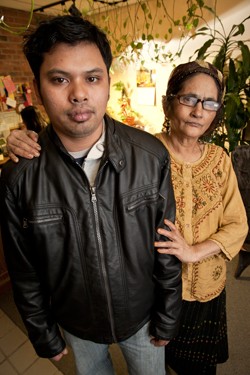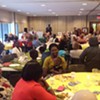Published January 15, 2014 at 12:46 p.m. | Updated November 17, 2015 at 10:16 a.m.
Their polychromatic presence is evident every day in Chittenden County’s supermarkets, schools and streets: Somali women in kaleidoscopic kangas brightening the Old North End; Vietnamese and Tibetan entrepreneurs selling banh mi or momo at food shops in Winooski; Bhutanese becoming suburban homeowners in Essex, Williston and South Burlington.
Since 1989, at least 6,300 men, women and children have come to Vermont through a federal refugee resettlement program. That 25-year total includes 1,705 Bosnians, mostly Muslims; 1,437 Bhutanese, many of whom had been living in exile in Nepal; and about 1,000 Africans fleeing violence in Burundi, Congo, Rwanda, Somalia and Sudan.
Hundreds of additional non-English-speakers from poor countries have made their way here as asylum seekers or ordinary immigrants. Another 300 or so are expected to arrive this year.
The large majority of these new Vermonters “have adapted successfully” to a society, economy and climate markedly unlike that of their homelands, says state refugee coordinator Denise Lamoureux. Those who suffered “severe traumas” have overcome even greater challenges, adds Michelle Jenness, director of Vermont Immigration and Asylum Advocates. “They show remarkable resilience and courage,” Jenness says.
Has the process been largely free of xenophobia or racism on the part of long-established Vermonters? Has the state lived up to its reputation for tolerance and compassion?
Yes and yes, say Lamoureux, Jenness and several other Vermont resettlement specialists, as well as almost all of the 15 immigrants interviewed by Seven Days. “Very few people don’t want to interact with you because of the color of your skin or your language,” says Thato Ratsebe, a Botswanan who works as deputy director of the Association of Africans Living in Vermont.
At the same time, Lamoureux cautions, “All transitions require effort, flexibility and adaptation.”
Those qualities could be strained as the proportion of immigrants in the Burlington area continues to grow. Laurie Stavrand, an outreach worker for the Colchester-based Vermont Refugee Resettlement Program, acknowledges the possibility of a “tipping,” or saturation, point. “We’ve been going through a long recession,” she notes, “and everybody has been trying to look out for themselves.”
Racial tensions two years ago at Burlington High School and in other local settings more recently suggest that the integration of nonwhites into a still heavily white part of the country is not without challenges. “Change is always hard,” concedes Judy Scott, director of the resettlement program. And that may be especially true in Vermont, which, Scott notes, “is very much behind the times, compared to the rest of the country, in becoming culturally diverse.”
Acts of insensitivity, if not outright hostility, do take place on occasion. Top leadership at Burlington’s City Market had to overrule a manager who insisted that foreign-born employees should be required to speak English on the job. Ratsebe says a few African refugees told her they were treated disrespectfully by employees at a different local supermarket because they had difficulty speaking English.
It’s impossible to gauge the degree of suspicion or resentment among white Vermonters toward immigrants of different skin colors — though the folks at Vermont Refugee Resettlement are especially attuned to prejudice. Hints of it occasionally surface. For example, an email message sent recently to a Seven Days staffer suggested that the status of some refugees should be “investigated.”
The writer recounted being at the downtown Burlington Rite Aid and seeing “an African refugee couple (the woman was in traditional dress) having the cashier process a money order for $300 to be sent out of the States — my guess was to relatives back home.” The couple “didn’t look well-off,” the writer added, “and could very well be getting Section 8 [rent subsidies] and/or food stamps. And considering how many people in VT are struggling financially, I’m sure no one would be happy to know that refugees are sending taxpayers’ money out of the country.”
Part of the writer’s supposition was likely correct. Immigrants from many places — not just Africa — do typically send funds to family members back home. These remittances, as they are known, constitute a cornerstone of the economy in countries with per-capita incomes of less than $1,000 a year.
The couple seen at Rite Aid may indeed have been receiving Section-8 assistance and/or food stamps. But that doesn’t mean they were jobless. In fact, about 95 percent of refugees in Vermont find work within six months of their arrival, says resettlement program employment counselor Alyssa Vigneault. And because many of these jobs pay less than $10 an hour, some immigrants have to work 60 hours or more per week in order to meet the high cost of rent in Chittenden County, Ratsebe notes.
Chandra Pokhrel, an employment counselor at AALV, calls housing “the single biggest challenge” faced by immigrants in the Burlington area.
Bhakta Rai said through a translator at AALV’s office in the Old North End that he pays $1,350 a month, not including utilities, for a three-bedroom apartment in Winooski that the Bhutanese immigrant shares with his wife and four children. Rai said he works part-time in a laundry while caring for his wife, who is ill. The family gets additional support from an adult son and daughter living nearby, he added.
The concerned emailer could have been giving expression to one of the urban myths spun about immigrants, Stavrand suggests. It’s sometimes assumed of refugees that “they’re all on welfare,” the resettlement program staffer says. But in addition to the housekeeping jobs they typically find, many refugees work as caregivers in nursing homes, where “they’re literally wiping the bottoms of our parents,” Stavrand points out.
Refugees do many of the least glamorous jobs in Vermont, a state with an aging population that is facing labor shortages, says Scott, the resettlement program’s director.
And many of them toil with purpose. Immigrants, almost by definition, are strivers. That’s a centuries-old story in the United States, and it’s being told again today in Vermont.
Consider the case of Ko Gyi, a Burmese refugee who works as a cook at the University of Vermont’s student center. He came to Burlington five years ago after spending 17 years in a refugee camp in Thailand. “I hope one day my children will go to UVM,” Ko said at the resettlement program’s office in Fort Ethan Allen. “I hope also one day to open my own food business.”
Refugees who find jobs — no matter how menial — are strongly motivated to continue working, adds Loan Nguyen, a Vietnamese immigrant who works as a counselor for the resettlement program. “People are really afraid,” she says. “When they get something here, they want to hold onto it. They don’t want trouble with the police. They don’t want to be hungry again.”
Another myth holds that all refugees are uneducated or were impoverished in their native countries, Stavrand notes. “We’ve had clients with PhDs,” she reports. “They had worked as professors. It’s simply not true that everyone from Africa comes here at the lowest possible economic level.”
Due in part to the assistance offered by organizations such as AALV, which serves refugees from all over the world, the Burlington area is seen as a hospitable destination for immigrants — especially in comparison to some other parts of the United States. During a recent visit to Atlanta, Pokhrel of AALV recounts, he heard reports of Bhutanese fighting with African refugees. “That sort of thing doesn’t happen here,” he observes. “Vermont people are friendly and kind.”
Vermont is regarded as such a welcoming place that many immigrants move here from elsewhere in the U.S., Ratsebe notes. She says AALV does not have statistics on such “secondary migrants,” but she estimates their number to be “substantial.”
In addition, “very few” immigrants to Vermont leave the state, Ratsebe says. The cost of housing may be prohibitive, but it’s easier to find jobs in Chittenden County than in many other metropolitan areas, she notes, adding that Vermont is also perceived as a safe environment where the children of immigrants can get a good education.
That’s evident in Chittenden County schools — particularly in Burlington and Winooski — where dozens of languages are spoken in addition to English. But could Chittenden County institutions and service providers reach a point when they are unable to respond adequately to the needs of a burgeoning refugee and immigrant population?
Lamoureux leads a network of service agency directors and local leaders that addresses such concerns at meetings held every six weeks. Their assessments — of impacts on housing, schools and the local labor force — generally indicate that the opportunities and assistance available in the Burlington area are sufficient to meet newcomers’ needs, Lamoureux reports. Last year, however, the agency network suggested to the U.S. State Department that the planned influx of 325 refugees to Vermont might be too large. It was subsequently agreed that the state would receive 300 refugees, Lamoureux recounts.
“We need to keep a balance between our capacity to continue to help refugees succeed and the desire of the federal program to maintain the numbers it thinks are appropriate,” she comments. “So far, the balance is there. I don’t see a time when there are too many refugees here.”
Harka Khadka is a Bhutanese refugee who works with disabled adults at the HowardCenter in downtown Burlington. His parents, who farmed in Bhutan, are both illiterate. But he received a bachelor’s degree in English literature while spending seven years at a camp in Nepal. Khadka says he’s pleased with the quality of teaching at Burlington High School, which his daughter attends. His 4-year-old son will attend kindergarten in Winooski, where Khadka has bought a home.
Although he has provided well for his family, Khadka says he knew from the outset five years ago that the experience of being a refugee “wasn’t going to be easy — even for a person like me. And it hasn’t been easy.”
Learning to drive a car presented unexpected difficulties, for example, as did his initial homesickness and the lack of jobs in Vermont during the depths of the Great Recession. Khadka says he has encountered no explicit prejudice based on his brown skin, although, he suggests, “maybe I have not noticed subtle types of discrimination.” Life in Bhutan, by contrast, involved “harsh discrimination that was always obvious,” Khadka explains.
Few refugees have come to Vermont under circumstances more harrowing than those experienced by Sudanese “Lost Boys.” Escaping mayhem in Sudan, they trekked hundreds of miles across arid expanses populated by human and animal predators to seek refuge in Kenya. Most of the Lost Boys who settled in Vermont after years in Kenyan camps have adjusted well to an utterly unfamiliar environment, refugee workers say.
But not all of them have found peace.
“There are problems for some with the freedom they have here,” remarks Atem Deng, a former Lost Boy who works as a machinist in Winooski. “They buy beer and can get in trouble.”
Adrie Kusserow, a St. Michael’s College anthropology professor who works with Sudanese refugees in Vermont, says some Lost Boys have not found work and struggle with depression as well as with alcohol abuse. “A lot have not had their dreams of education fulfilled,” she adds. “They’re also under pressure to send money home, and many are looking for wives in Sudan. It’s tough to negotiate the bride price in cows from here” — a reference to the sub-Saharan tradition of using livestock as currency to win the consent of a potential bride’s family.
Vermont’s vicious winters don’t pose as big a problem as is commonly supposed for Africans and immigrants from other tropical climes, says Vigneault, the job counselor at the resettlement program. “I told a guy from Iraq a while ago who was wearing a thin jacket that he had to put on a parka or he’d get hypothermia,” Vigneault relates. “He told me, ‘It’s fine like this. I’ve been too hot for a long time.’”
Acclimating to freezing temperatures is “nothing, compared to what they’ve experienced in refugee camps,” Ratsebe adds. “They’re survivors. Being cold is not a big deal for them.”
Cultural factors taken for granted by those born in the U.S. can present much greater challenges than Vermont’s weather, some refugees say.
Ahmed Yousif Shareef, an Iraqi immigrant who worked as a translator for the U.S. Army in combat zones such as the city of Fallujah, identifies “the pace of life” and “closely scheduled free time” as aspects of life in the U.S. that have proved hardest for him to adjust to. “At home there was no time limit on socializing,” notes Shareef, who works as a pharmacy technician in Williston. “We all lived near one another and just hung out. Here, you’ve got to work hard at keeping friends.”
Acquiring English fluency is essential for immigrants seeking to climb the job ladder, refugee counselors point out. But learning English can prove quite difficult for some refugees. U.S. admissions programs make no provision for teaching English, leaving it to nongovernmental groups such as the refugee resettlement program to help immigrants find language instruction.
Liliane Ndizihiwa, a refugee from war and hunger in Congo who arrived in Vermont nine months ago, appeared lost as she sat on a bench in AALV’s office, waiting to get help in applying for Medicaid. “I go to the health center but they give me papers to fill out I did not understand,” she said in halting English. “It’s hard for me to learn how to speak,” added Ndizihiwa, who works part-time at the Autumn Harp cosmetics factory in Essex Junction.
Happy endings to sagas such as hers are not guaranteed. But U.S. history does show that many immigrants gradually assimilate into American society. Older refugees, such as 68-year-old Ah Chan from Burma, may remain outside the U.S. mainstream, but her son, Ko Gyi, the UVM cook, says he finds it easy to make friends with American natives. And Ko’s children will probably ease into local ways and adopt them as their own.
Khadka, the Bhutanese refugee who works at the HowardCenter, is seeing this process unfold in his family. “We still like to eat curry, lentils and rice,” he says about himself and his wife. But his kindergarten-age son “won’t eat our food,” he laments with a wry smile. “He wants hamburgers and French fries and ice cream.”
Contact: [email protected]
More By This Author
About the Artist

Matthew Thorsen
Bio:
Matthew Thorsen was a photographer for Seven Days 1995-2018. Read all about his life and work here.
Matthew Thorsen was a photographer for Seven Days 1995-2018. Read all about his life and work here.
Speaking of...
-

At the Junction of State and Federal Law, I-91 Checkpoint Becomes Site of Legal Collision
Feb 5, 2014 -

Maple Makeover? Vermonters Discover a New Sugaring Technique
Feb 5, 2014 -

Disharmony on Prospect Street: A Dispute Between Neighbors Strikes a Sour Note
Feb 5, 2014 -

Treatment or Trial? Growing 'Rapid-Intervention' Program Gives Addicted Offenders a Choice
Jan 29, 2014 -

Raw Deal? Farmers Push Back Against Unpasteurized Milk Regulations
Jan 29, 2014 - More »
Comments
Showing 1-1 of 1
Comments are closed.
From 2014-2020, Seven Days allowed readers to comment on all stories posted on our website. While we've appreciated the suggestions and insights, right now Seven Days is prioritizing our core mission — producing high-quality, responsible local journalism — over moderating online debates between readers.
To criticize, correct or praise our reporting, please send us a letter to the editor or send us a tip. We’ll check it out and report the results.
Online comments may return when we have better tech tools for managing them. Thanks for reading.













































